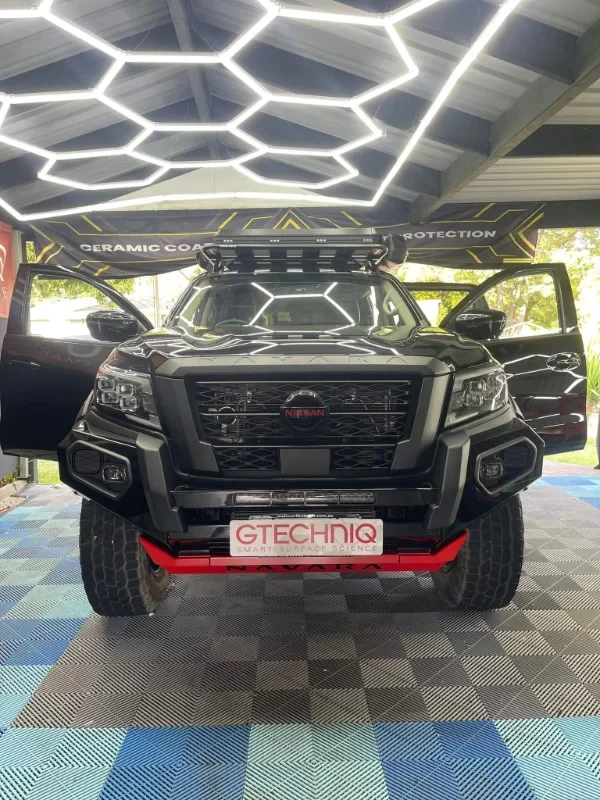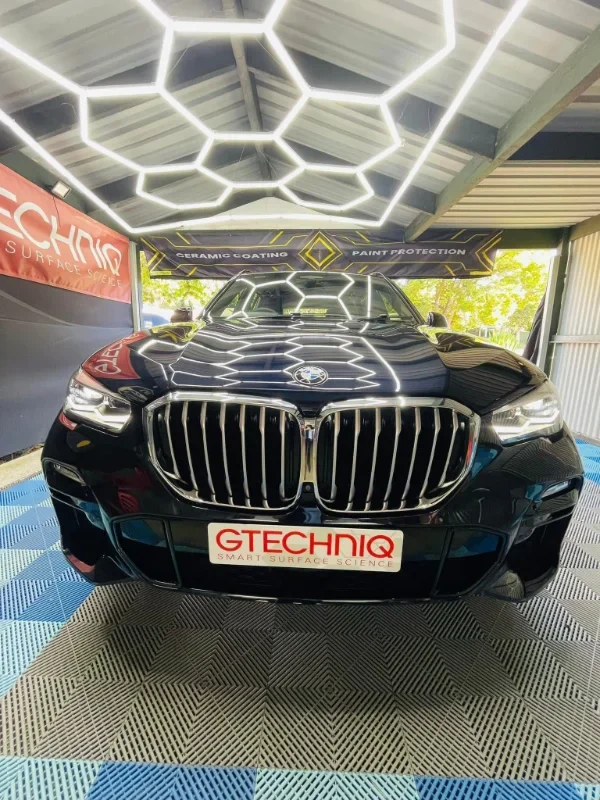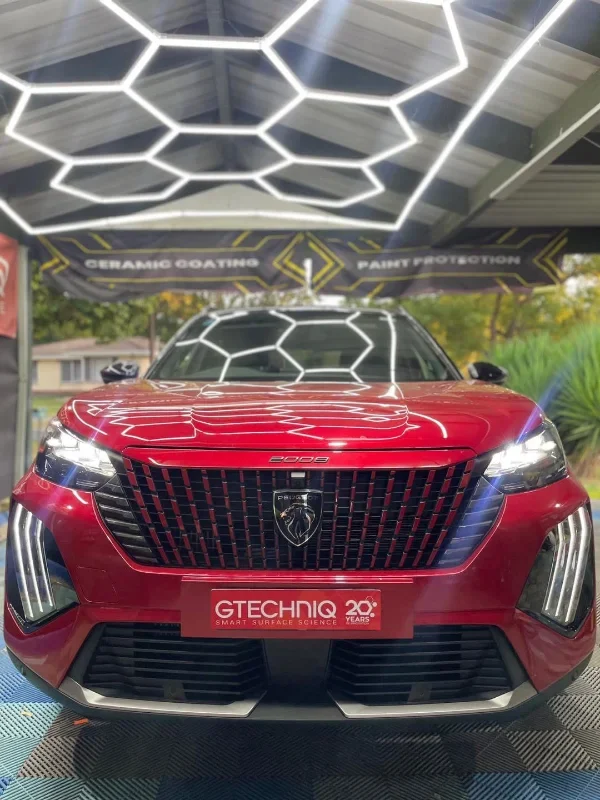The science behind window tinting’s heat-reducing capabilities involves sophisticated interactions between solar radiation and engineered materials. When sunlight hits your vehicle, it carries energy across multiple wavelengths that behave differently when encountering window films. Understanding these scientific principles reveals why certain films achieve remarkable temperature reductions while others provide minimal benefits.
Modern window tinting technology represents advanced materials science applied to everyday problems. The effectiveness goes far beyond simply darkening glass – it involves precise manipulation of electromagnetic radiation through carefully designed particle systems and multi-layer constructions.
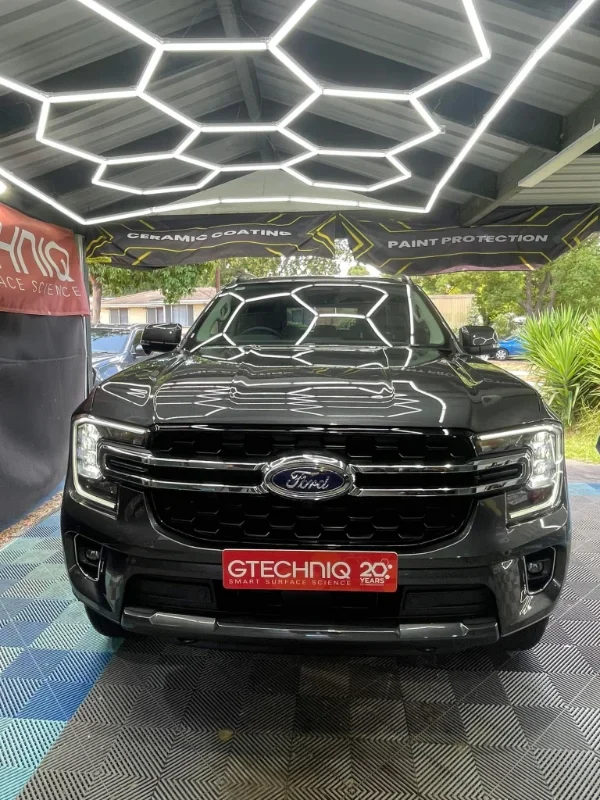
How Solar Radiation Creates Heat in Vehicles
Solar energy reaches Earth as electromagnetic radiation containing three distinct components that each contribute differently to vehicle heating. This radiation spectrum includes visible light at 44%, infrared energy at 53%, and ultraviolet rays at 3% of total solar energy.
The Role of Infrared Radiation
Infrared radiation carries the primary responsibility for heating vehicle interiors. Unlike visible light, infrared energy remains invisible to human eyes but immediately converts to thermal energy when absorbed by surfaces. Your dashboard, seats, and interior panels function as heat collectors, absorbing this energy and radiating warmth throughout the cabin.
This thermal loading process creates continuous heat addition to enclosed spaces. Without intervention, infrared energy causes interior temperatures to climb rapidly, often reaching dangerous levels that affect both comfort and safety.
Visible Light Heat Contribution
While infrared dominates heat production, visible light also contributes significantly to thermal buildup. When visible wavelengths strike dark interior surfaces, they get absorbed and converted to heat energy. This explains why vehicles with black dashboards and dark upholstery feel substantially hotter than those with light-colored interiors.
Managing visible light presents challenges because adequate visibility must be maintained for safe driving. Advanced window films address this through selective filtering that distinguishes between beneficial and problematic wavelengths within the visible spectrum.
Ultraviolet Energy Effects
Ultraviolet radiation contributes less to immediate heating but carries high energy per photon. UV radiation causes long-term damage to interior materials through photochemical reactions that break down plastics, fade fabrics, and deteriorate leather surfaces. This degradation process also generates additional heat as molecular bonds break down.
The Physics Behind Window Film Technology
Window tinting operates through precisely engineered materials that interact with specific wavelengths of solar radiation. Modern films incorporate multiple technologies designed to manage energy transfer through reflection, absorption, and selective transmission mechanisms.
Ceramic Nanoparticle Engineering
Ceramic window films utilize precisely engineered nanoparticles that selectively interact with infrared radiation while remaining transparent to visible light. These ceramic materials are sized and distributed to target specific wavelengths, creating films capable of rejecting up to 99% of infrared energy.
The ceramic particles maintain molecular stability under extreme temperatures and ultraviolet exposure, ensuring consistent performance throughout the film’s lifetime. Unlike organic materials that degrade over time, ceramic compounds retain their filtering properties indefinitely.
Multi-Layer Construction Techniques
Advanced window films employ multiple layers to achieve specific performance characteristics. These constructions combine adhesive layers, particle-embedded cores, protective coatings, and specialized surface treatments. Each layer serves distinct functions in managing solar energy and ensuring long-term durability.
This layered approach allows combining different technologies within single films. For example, ceramic particles might handle infrared rejection while UV-blocking compounds occupy separate layers, creating comprehensive solar energy management systems.
Scientific Measurement of Heat Rejection Performance
Professional testing quantifies window film performance through standardized protocols that measure energy transmission, reflection, and absorption. These measurements provide objective data for comparing technologies and predicting real-world effectiveness.
Total Solar Energy Rejected (TSER) Testing
TSER measures the percentage of total solar energy that window films prevent from entering enclosed spaces. This comprehensive metric includes all forms of solar radiation, providing overall heat rejection capability indicators. Films with higher TSER values typically deliver superior cooling performance under identical conditions.
Laboratory TSER testing exposes film samples to standardized solar radiation while measuring transmitted energy across the complete solar spectrum. Results account for reflection, absorption, and transmission characteristics, generating accurate performance profiles.
Infrared Rejection Measurement
Since infrared radiation contributes most significantly to heat buildup, measuring infrared rejection specifically provides crucial performance information. High-performance films can reject 90% or more of infrared energy while maintaining excellent visible light transmission.
Testing focuses on wavelengths between 780 and 2500 nanometers, encompassing the infrared spectrum most relevant to vehicle heating. Advanced films demonstrate selective filtering capabilities that target these wavelengths while preserving beneficial visible light passage.
Visible Light Transmission Standards
Visible Light Transmission (VLT) measures how much visible light passes through window films. This metric directly affects visibility and influences film appearance. Modern technology achieves high VLT values combined with excellent heat rejection, providing clear visibility while maintaining cooling performance.
VLT testing uses photopic response curves matching human eye sensitivity to different visible wavelengths. This ensures measurements reflect actual visibility conditions rather than simple light transmission across all frequencies.
Different Film Technologies and Their Heat Management Approaches
Various window film technologies employ different scientific approaches to achieve heat reduction. Understanding these mechanisms explains performance differences and helps identify optimal technologies for specific applications.
Absorptive Film Mechanisms
Absorptive films capture solar energy within the film material rather than allowing it to reach interior surfaces. These films convert solar energy to heat within themselves, then dissipate that thermal energy to the outside environment through conduction and convection processes.
Carbon-based films exemplify absorptive technology, using carbon particles to capture and contain solar energy. While the film becomes warm, it prevents significantly more heat from reaching vehicle interiors. The absorbed energy transfers away from cabins through contact with outside air flowing over film surfaces.
Reflective Film Properties
Reflective films bounce solar energy back toward its source before conversion to heat occurs. This approach proves more effective than absorption because reflected energy never becomes thermal energy near vehicles. Metallic particles within these films act as microscopic mirrors, redirecting unwanted solar radiation.
The reflection mechanism works most effectively with infrared radiation, which has longer wavelengths that interact readily with appropriately sized metallic particles. Reflected energy returns to the atmosphere rather than contributing to vehicle heating.
Selective Filtering Advanced Technologies
The most sophisticated films employ selective filtering that treats different wavelengths according to specific requirements. These films allow beneficial visible light passage while blocking harmful infrared and UV radiation through targeted wavelength management.
Selective filtering requires precise engineering of particle size, distribution, and material properties. This technology optimizes multiple performance characteristics simultaneously – maintaining visibility, rejecting heat, and blocking UV radiation through advanced materials science applications.
Real-World Scientific Studies on Temperature Reduction
Extensive research documents temperature reductions achieved through window tinting under various environmental conditions. These studies provide concrete evidence of performance and validate theoretical predictions about heat rejection capabilities.
Laboratory Controlled Testing Results
Laboratory studies measure temperature differences between tinted and untinted glass samples under controlled solar radiation exposure. These tests eliminate weather variables and provide baseline performance data. Results consistently demonstrate significant temperature reductions, with high-performance films reducing heat transmission by 40-70%.
Environmental chambers simulate various conditions including different sun angles, ambient temperatures, and humidity levels. This comprehensive testing reveals how film performance varies under changing circumstances and helps predict real-world effectiveness across different climates.
Vehicle Interior Temperature Field Studies
Field research measuring actual vehicle interior temperatures demonstrates practical window tinting benefits. Studies comparing identical vehicles with and without films show interior temperature reductions of 8-15 degrees Fahrenheit during peak solar conditions.
Dashboard temperature measurements reveal even more dramatic differences, with tinted vehicles showing reductions up to 40 degrees Fahrenheit. These surface temperature reductions are particularly important for protecting interior materials and preventing contact burns from overheated surfaces.
Companies specializing in window tinting Adelaide have contributed valuable data to these studies, providing real-world performance information under Australian climate conditions. Professional installers like KD Auto Detailing regularly document temperature improvements in client vehicles, adding to the scientific understanding of film effectiveness.
The Greenhouse Effect Physics in Enclosed Vehicles
Vehicle interiors create perfect conditions for greenhouse effects, where solar energy enters easily but heat struggles to escape. Understanding this phenomenon explains why window tinting provides such significant temperature control benefits.
Heat Trapping Mechanisms
Solar energy passing through untinted windows gets absorbed by interior surfaces and converted to thermal energy. This heat then becomes trapped within enclosed cabin spaces, unable to escape back through windows. The result is rapid temperature buildup continuing until interiors reach equilibrium with incoming solar energy.
Interior materials like dashboards, seats, and door panels function as heat absorbers and radiators. Once heated, these surfaces continue radiating thermal energy even when direct sunlight gets blocked, contributing to sustained high temperatures throughout vehicles.
Breaking the Greenhouse Cycle
Window tinting interrupts greenhouse effects by preventing solar energy from initially entering vehicles. Instead of attempting to remove heat after generation, tinting stops heat production at its source. This prevention approach proves far more energy-efficient than cooling superheated interiors through air conditioning alone.
Prevention creates compounding benefits throughout vehicle systems. Cooler interior surfaces mean less radiant heat, resulting in lower air temperatures, which reduces cooling system workloads. This cascade effect amplifies initial energy blocking provided by quality window films.
Energy Efficiency and Environmental Impact
Window tinting significantly impacts vehicle energy efficiency by reducing air conditioning system workloads. This efficiency improvement translates to measurable benefits in fuel consumption and environmental impact reduction.
Air Conditioning Load Reduction
When interior temperatures start lower due to effective window tinting, air conditioning systems require substantially less energy to achieve comfortable conditions. Compressors work less intensively, fans operate at lower speeds, and target temperatures are reached more quickly and maintained more easily.
Scientific studies measuring air conditioning power consumption show 15-30% reductions in energy use with effective window films. This efficiency improvement becomes most pronounced during extreme heat conditions when cooling demands reach their highest levels.
Long-Term Performance Benefits
Beyond immediate energy savings, window tinting contributes to thermal comfort and occupant safety. Lower interior temperatures reduce heat stress on passengers and prevent dangerous surface temperatures capable of causing burns. Dashboard temperatures in untinted vehicles often exceed 180 degrees Fahrenheit, while tinted vehicles typically remain below 140 degrees.
These comfort benefits extend beyond temperature control to include reduced glare and eye strain. Quality window films filter harsh glare while maintaining visibility, contributing to safer and more comfortable driving experiences under various lighting conditions.
KD Auto Detailing Serving the Paradise Community and Beyond in Adelaide
KD Auto Detailing is dedicated to serving the diverse needs of the local community of Adelaide, including individuals residing in neighbourhoods like Paradise. With its convenient location near landmarks such as the Warrina Park, Charles Campbell College, Thorndon Park Estate, Thorndon Park Est and major intersections like George St & Urban Ave and Silkes Rd & George St (coordinates: -34.8730203, 138.6769206), we offer window tinting services.
Navigate from Paradise to KD Auto Detailing Now
Key Scientific Findings on Heat Reduction with Window Tinting
- Infrared (IR) Radiation Blocked: Up to 97% of infrared light from the sun is blocked by high-quality window tint (ClimatePro, 2024).
- Ultraviolet (UV) Ray Filtration: Over 99% of harmful UV rays are filtered out, protecting interiors and skin (ClimatePro, 2024).
- Solar Heat Reduction: Window films can reduce solar heat gain by up to 60% in buildings and up to 79% in summer months (Custom Tint Solutions, 2024).
- Interior Temperature Drop: Window tinting can lower interior temperatures by 8 to 20°F (4.5 to 11°C) in vehicles, significantly improving comfort (Extreme Car Audio LLC, 2025).
- Total Solar Energy Rejection (TSER): Combines UV, visible light, and IR blocking; higher TSER means better heat rejection and energy savings (5Star Auto Detail, 2024).
- Types of Tint & Heat Rejection:
- Ceramic tint: Blocks up to 98% of infrared heat, excellent UV protection, no electronic interference.
- Carbon tint: Blocks ~40-50% heat, durable with glare reduction.
- Metalized tint: Blocks up to 70% heat but may interfere with electronics (Lux Auto Spa LLC, 2025).
Scientific Mechanism: Window tinting works by selectively filtering and reflecting solar radiation wavelengths responsible for heat buildup—primarily infrared and UV rays—while allowing visible light to pass, maintaining natural brightness without overheating.
[Visual suggestion: Bar chart comparing % heat/IR/UV blocked by Ceramic, Carbon, Metalized tint + line showing interior temperature drop range]

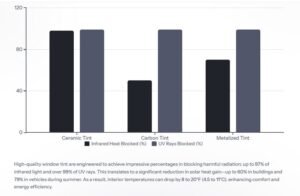
Sources: ClimatePro, Custom Tint Solutions, Extreme Car Audio LLC, Lux Auto Spa LLC, 5Star Auto Detail (2024-2025)
Key Takeaways About Heat Reduction Science
Scientific exploration into window tinting confirms its role as more than an aesthetic addition. By filtering specific wavelengths of solar radiation, films significantly reduce indoor heat, lower ultraviolet damage, and improve long-term comfort. From nanotechnology-driven innovations to environmental contributions, the science demonstrates that window tinting is an effective and measurable solution for controlling the impacts of solar energy.
Frequently Asked Questions
How do window films block heat without making glass completely dark?
They use reflective, absorptive, or nanotechnology-based layers that target infrared and UV rays while still allowing visible light.
Can tinted glass stop all forms of solar energy?
No. Films are designed to minimize, not eliminate, heat transfer. They significantly reduce infrared and UV penetration but allow controlled amounts of visible light.
What scientific tools measure film effectiveness?
Spectrophotometers and thermal imaging are used to test how much radiation is transmitted, reflected, or absorbed by window films.
Why does untreated glass allow so much heat inside?
Untreated glass permits solar radiation to pass through and trap energy indoors, creating a greenhouse effect.
What is the role of nanoparticles in ceramic films?
Nanoparticles target and block specific wavelengths of infrared radiation, providing superior heat reduction without interfering with clarity or signals.

